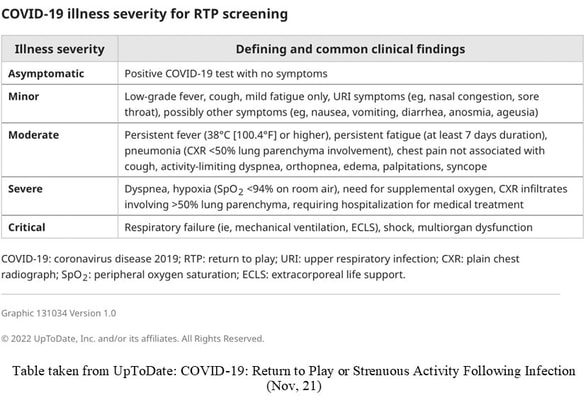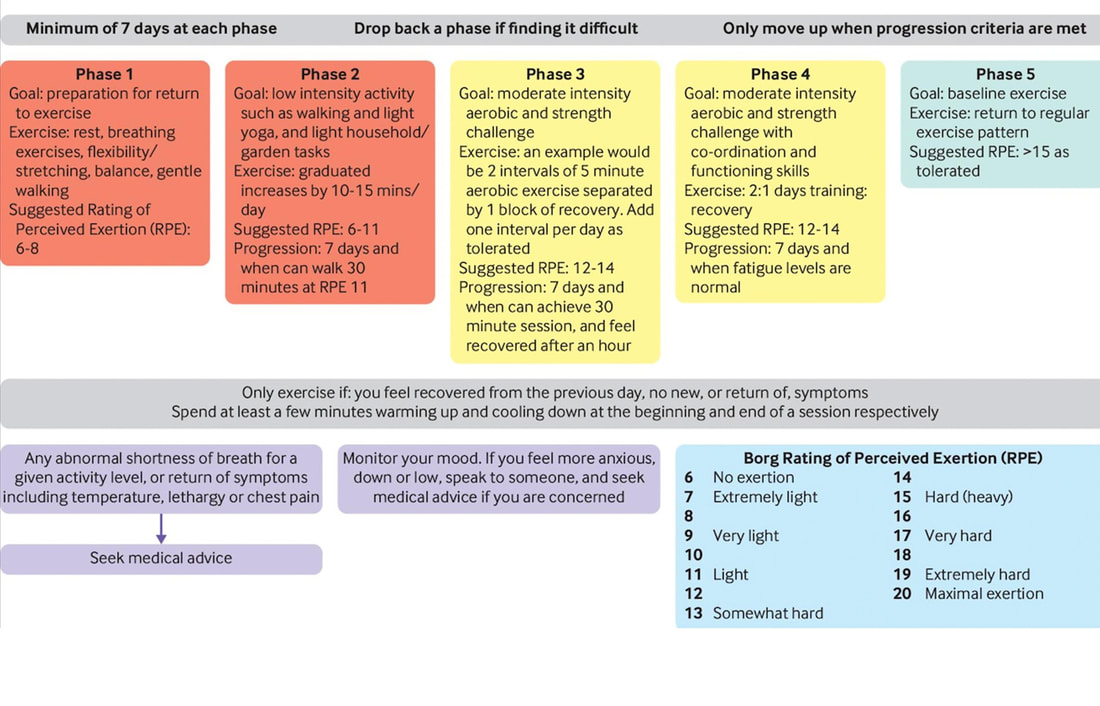I will begin with my key, take-away, messages from having read through the material and will then present some material in further detail.
Key Messages:
- Be kind to yourself in the early stages following COVID-19 diagnosis. Even if you have very minor to no symptoms, the recommendations are to prioritise rest and recovery and not to exercise during this period. Focus on nutrition, hydration and rest.
- In some circumstances it is strongly encouraged to seek medical advice prior to returning to exercise. The most notable of these are: any cardiac (heart) symptoms, moderate-severe symptoms in initial infection phase and onset of particular symptoms during activity.
- Monitor your mental health. Both the initial illness period and the recovery process can be difficult to deal with at times and if you notice yourself struggling then seek out assistance.
The Cleveland Clinic: Returning to Sports or Exercise After Recovering From COVID-19 (Feb ‘21) https://health.clevelandclinic.org/returning-to-sports-or-exercise-after-recovering-from-covid-19/?fbclid=IwAR0pROpVxvqkqV401LM9DAKW3Zq9fbsHE7ExzqEbKx1QBVaDJ3Yd3_Lgtdw
The BMJ (previously the British Medical Journal): Returning to Physical Activity After COVID-19 (Jan ‘21)
https://www.bmj.com/content/372/bmj.m4721?fbclid=IwAR2Zzd3KeFgJ7Q8OigFJ6KHDqUVCdQGYuQYlsjz6Tl0Fu_9cASzbhhMo8Sc
UpToDate: COVID-19: Return to Play or Strenuous Activity Following Infection (Nov, 21) https://www.uptodate.com/contents/covid-19-return-to-play-or-strenuous-activity-following-infection?fbclid=IwAR2Zzd3KeFgJ7Q8OigFJ6KHDqUVCdQGYuQYlsjz6Tl0Fu_9cASzbhhMo8Sc
Severity of Symptoms
All three guidelines agree that if you have had minor symptoms during your illness then you can follow a self directed return to activity. However, if you have had moderate or severe symptoms during illness then your return to activity should be directed by a medical professional and may include multiple tests to clear you for activity.
All three guidelines agree that if your symptoms included any cardiac issues then you should consult a medical professional before returning to activity. The main cardiac symptoms to watch out for are: chest pain, palpitations, breathlessness or fainting/blacking out (syncope).
Psychological Symptoms
There is a portion of people that experience significant psychological symptoms/distress during their COVID-19 illness. It is recommended that these individuals also seek medical advise before returning to activity.
Stages for Self-directed Return to Activity:
If you had a minor version of the illness, no cardiac symptoms and no significant adverse change to your mental health then you are a candidate to self-direct your return to exercise.
After reading through multiple sets of guidelines, combined with my own personal experience I would personally follow and recommend the guidelines set out by BMJ.
The BMJ guidelines is a 5 phase program with a recommendation for a minimum of 7 days per phase. These guidelines state ‘Only exercise if: you feel recovered from the previous day, no new, or return, of symptoms’. They also encourage people to ‘Spend a few minutes warming-up and cooling-down’ at the beginning and end of each session’.
It is my opinion that the effort levels and times included in this table seem most appropriate for those who had at least a moderate-good exercise capacity prior to COVID-19 infection. For those that had lesser capacity prior to infection a graded return to exercise is still recommended but times and intensities will vary.
The Cleveland Clinic also lists some other symptoms that people may experience during a return to activity following COVID-19. These are:
- Chest pain or heart palpitations
- Nauseous
- Headache
- High heart rate not proportional to exertion level or prolonged heart rate recovery
- Feeling lightheaded or dizzy
- Shortness of breath, difficulty catching breath or abnormal, rapid breathing
- Excessive level of fatigue
- Swelling in the extremities
- Syncope (passing out)
- Experiencing tunnel vision or loss of vision
According to the Cleveland Clinic recommendations these symptoms can be self monitored, rest for a period of time and then return to activity. In my opinion these symptoms are significant enough to warrant medical attention and advice.
I hope this has been a useful collection of information for you. If you would like more guidance and support in your return to exercise after illness please contact our clinic. Our physiotherapists will work with you to create training programs and exercise progressions to build your health and fitness back up.
Author: Jonathan Schubert Senior Sports and Musculoskeletal Physiotherapist
Jonathan is a highly skilled and experienced Musculoskeletal and Sports Physiotherapist, having graduated from the University of South Australia in 2006 with a Bachelor of Physiotherapy, and his Masters in Sports Physiotherapy and a Masters of Musculoskeletal Physiotherapy, from LaTrobe University in 2016.
In Part 1 of this blog, Jonathan shared the effect running an ultramarathon shortly after having a viral illness had on him, and his journey back to health and full fitness. Read it here.
Outside of the clinic, Jonathan spends several hours per week as a clinical educator for UniSA’s physiotherapy students, and enjoys running, cycling and spending time with his family. Jonathan loves to help his patients optimise their movement, live pain-free, and achieve their health goals. He has a special interest in running, football, cycling and gymnastics.



 RSS Feed
RSS Feed